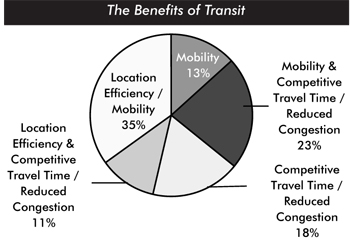
The Importance of Transit
Transit enhances the quality of life of the American people. It offers basic mobility to people who either do not own or have access to a car, convenient and efficient mobility to people who live and work in densely populated areas where travel by car does not make sense, and competitive travel times and reduced road congestion for people traveling to and from work along major transportation corridors in large metropolitan areas. Chapter 14 draws on two surveys of transit riders—The National Household Travel Survey (NHTS), a national survey, and the Transit Performance Monitoring System (TPMS) a snapshot of smaller systems with more transit-dependent riders.
The NHTS found that 44 percent of nationwide transit riders come from households without cars; TPMS found that 70 percent of trips were made by riders from households without cars. Getting to and from work accounts for the highest percentage of transit trips. Transit also is used to obtain educational, medical, personal business, and recreational services. The following pie chart shows shares of mobility, location efficiency, competitive travel time, and reduced congestion benefits provided by transit to TPMS riders. In many cases, trips provide more than one benefit. Transit also provides environmental and other benefits not captured by onboard passenger surveys.


